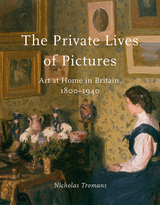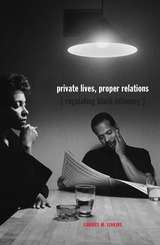
What is a family? Grandparents, mom, dad, and kids around a Thanksgiving turkey? An egg mother, a womb mother, a sperm donor, and their mutual child? Two gay men caring for their adopted son? In this provocative essay, a leading American legal historian argues that laws about family are increasingly laws about individuals and their right to make their own, sometimes contentious, choices.
Drawing on many revealing and sometimes colorful court cases of the past two centuries, Private Lives offers a lively short history of the complexities of family law and family life--including the tensions between the laws on the books and contemporary arrangements for marriage, divorce, adoption, and child rearing. Informal common-law marriage was once widely accepted as a means to regularize property arrangements, but it declined as the state asserted its authority to dictate who could marry and reproduce. In the twentieth century, state attempts to control private life were swept away, most famously in the creation of "no-fault" divorce, a system in which laws that made divorce nearly unattainable were circumvented.
Private life, the author argues, as a legitimate sphere, was once basically confined to life in nuclear families; but the modern law of "privacy" extends the accepted zone of intimate relations. The omnipresence of the media and our fascination with celebrity test the boundaries of public and private life. Meanwhile, laws about cohabitation and civil unions, among others, suggest that family and commitment, in their many forms, remain powerful ideals.

The Private Lives of Pictures offers a new history of British art, seen from the perspective of the home. Focusing on the nineteenth and early-twentieth-century, the book takes the reader on a tour of an imaginary Victorian or Edwardian house, stopping in each room to look at the pictures on the walls. Nicholas Tromans opens up the intimate history of art in everyday life as he examines a diverse array of issues, including how pictures were chosen for each room, how they were displayed, and what role they played in interior design. Superbly illustrated, The Private Lives of Pictures will appeal to readers interested in both art and social history, as well as the history of interiors.

Private Lives, Proper Relations begins with the question of why contemporary African American literature—particularly that produced by black women—is continually concerned with issues of respectability and propriety. Candice M. Jenkins argues that this preoccupation has its origins in recurrent ideologies about African American sexuality, and that it expresses a fundamental aspect of the racial self—an often unarticulated link between the intimate and the political in black culture.
In a counterpoint to her paradigmatic reading of Nella Larsen’s Passing, Jenkins’s analysis of black women’s narratives—including Ann Petry’s The Street, Toni Morrison’s Sula and Paradise, Alice Walker’s The Color Purple, and Gayl Jones’s Eva’s Man—offers a theory of black subjectivity. Here Jenkins describes middle-class attempts to rescue the black community from accusations of sexual and domestic deviance by embracing bourgeois respectability, and asserts that behind those efforts there is the “doubled vulnerability” of the black intimate subject. Rather than reflecting a DuBoisian tension between race and nation, to Jenkins this vulnerability signifies for the African American an opposition between two poles of potential exposure: racial scrutiny and the proximity of human intimacy.
Scholars of African American culture acknowledge that intimacy and sexuality are taboo subjects among African Americans precisely because black intimate character has been pathologized. Private Lives, Proper Relations is a powerful contribution to the crucial effort to end the distortion still surrounding black intimacy in the United States.
Candice M. Jenkins is associate professor of English at Hunter College, City University o

The eleven chapters in this volume explore the process of carving out, in discourse and in practice, the boundaries delineating the state, the civil sphere, and the family in Japan from 1600 to 1950.
One of the central themes in the volume is the demarcation of relations between the central political authorities and local communities. The early modern period in Japan is marked by a growing sense of a unified national society, with a long, common history, that existed in a coherent space. The growth of this national community inevitably raised questions about relationships between the imperial government and local groups and interests at the prefectural and village levels. Moves to demarcate divisions between central and local rule in the course of constructing a modern nation contributed to a public discourse that drew on longstanding assumptions about political legitimacy, authority, and responsibility as well as on Western political ideas.

The heroes of World War II were often heroines. This full and spirited account of the impact of the war on the private and public lives of American women provides a model for future social histories of twentieth-century America.
Using a wealth of new archival and statistical data, D'Ann Campbell explores the response of women throughout the country to the war emergency. She studies all the major roles, whether in the military, in nursing, in war factories, in volunteer work, or in the home, and she delineates experiences among different social classes, races, and age groups. Especially comprehensive is her discussion of the resistance of men to the new roles of women in the military, in the business world, and in labor unions.
Most women, Campbell finds, sought to protect and enrich their private spheres. She examines the challenges faced by housewives—shortages, migrations, rationing—and the emotional upheaval inside the family as husbands were sent to war. With the coming of peace, women consolidated their devotion to private values, and the result was the suburban life style revolving around the family that typified the 1950s. While Campbell looks back to the depression years and forward to the 1980s, her concern is with the women of the early 1940s. To their needs, values, and expectations, and to the tensions of the era between patriotic demands and private desires, she brings a clear and balanced view and shrewd, imaginative insight.
READERS
Browse our collection.
PUBLISHERS
See BiblioVault's publisher services.
STUDENT SERVICES
Files for college accessibility offices.
UChicago Accessibility Resources
home | accessibility | search | about | contact us
BiblioVault ® 2001 - 2024
The University of Chicago Press









